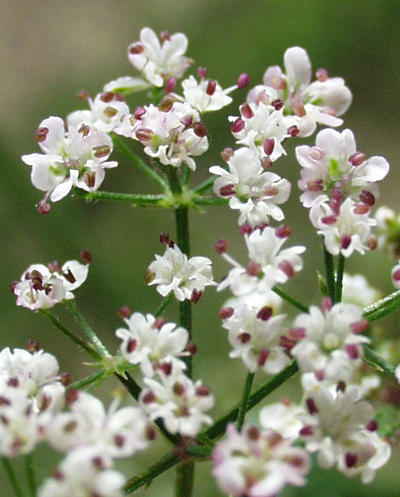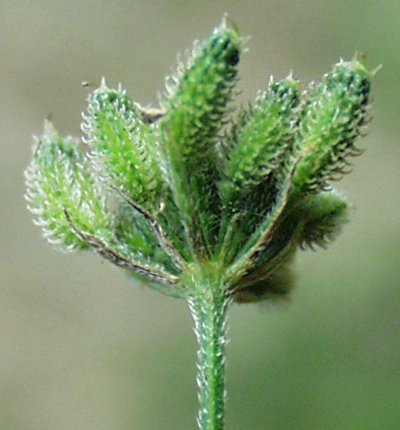Torilis, hedge parsleys |

Flowers of the Japanese hedge parsley

From the fruit of the Japanese hedge parsley torilin is extracted
The genus includes about 15 species and is found on every continent. It consist of annual or rarely perennial, hairy or bristly hairy herbs with a taproot. The stems are and upright or decumbent, branched and grooved. The leaves are 1- to 2-fold pinnate, opposite and covered with appressed hairs. The leaflets of the last order are elongated and serrated, lobed or pinnatisect.
The inflorescences (double umbels) are terminal and/or lateral, stalked or sessile. The umbels with 2 to 12 rays have either no involucre or up to 12 awl-shaped bracts. The involucel consists of 2–8 awl-shaped or lanceolate raylet leaves. The umbellules are either sessile or have 2–12 rays, which bearing white or red-purple flowers. They have 5 petals with inwardly bent apices. The marginal petals are not or only slightly enlarged. The calyx lobes are small and triangular or lanceolate. The two short styles arise from a thick, conical stylopodium.
After insect pollination the inferior ovary forms 2–6 mm long fruits which are round to elongated, laterally flattened, ribbed and covered with curved or hooked bristles. They are composed of 2 mericarps, which junction is quite narrow.
| Floral formula mostly: |
| * K5 C5 bzw. C0 A5 G(2) inferior |
Torilin
A medicinal agent, which is obtained from the fruit of Torilis japonica, is the sesquiterpene torilin. Laboratory tests have shown that torilin can be targeted against multi-drug-resistance of cancer cells, which are tumor cells, that are resistant to cytostatic agents. The torilin inhibits the P-glycoprotein – a membrane protein, which transports the drugs out of the cell under energy consumption.
Furthermore, torilin can be used against hyperpigmentation of the skin. The production of melanin, the coloring of the skin, is first initiated by the hormone α-MSH, which binds to a receptor in the cell membrane. Thereby, the cAMP concentration is increased, mediated by a G-protein in the cell plasma. This in turn means, that a protein kinase is activated, which indirectly (via transcription factors) stimulates the biosynthesis of tyrosinase – the enzyme which synthesized melanin via intermediates from tyrosine. Torilin reduces the synthesis of tyrosinase without inhibiting the enzyme.
Torilin is also an inhibitor of steroid 5-reductases that convert testosterone into dihydrotestosterone, which is responsible among other things for the body hair of the man and the function of the prostate. As inhibitor for the testosterone-5-alpha reductase, torilin can be used against hair loss and prostate enlargement.
Meaning of the species name
- japonica: lat. japonicus = Japanese
Interesting notes
Torilis japonica is used in Korea against amnesia, pruritus, acidosis and scabies.
The fruits of the hedge parsleys have small hooks, with which they can become lodged in human clothing or in the fur or in feathers of animals. So the plants ensure their own spreading.